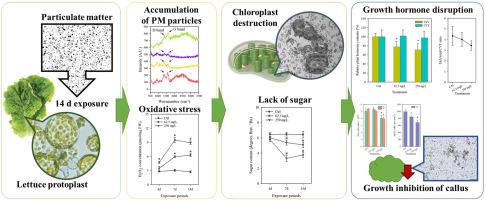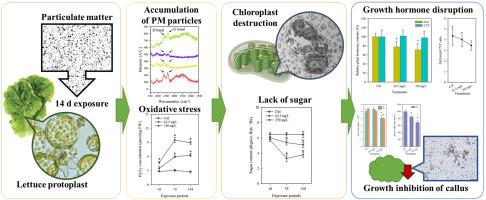暴露于颗粒物的生菜愈伤组织的生长抑制:细胞损伤与细胞内积累有关
IF 7.3
2区 环境科学与生态学
Q1 ENVIRONMENTAL SCIENCES
引用次数: 0
摘要
颗粒物质(PM)污染对植物细胞健康构成重大但尚未得到充分研究的风险。该研究表明,生菜(Lactuca sativa)原生质体-愈伤组织系统暴露于与环境相关浓度的标准化柴油废气颗粒中,会导致细胞内显著的PM积累、严重的细胞结构损伤和叶绿体完整性的破坏。PM暴露引发浓度依赖性氧化应激,过氧化氢增加,抗氧化能力受损,导致叶绿素和糖含量降低,光合作用受损。重要的是,我们发现生长素-细胞分裂素的相互作用表明激素失衡,并伴随着芽分化基因ARF5和AIL6PLT3的上调,作为对细胞损伤的代偿反应。这些结果表明,PM在植物细胞中的毒性是由细胞内积累、氧化损伤、代谢破坏和激素稳态改变驱动的,最终抑制了植物的早期生长。我们的研究结果强调了基于原生质体的检测方法在快速阐明植物毒性机制方面的价值,并表明这些生物标志物可以改善对环境PM对作物和生态系统影响的预测。本文章由计算机程序翻译,如有差异,请以英文原文为准。


Growth inhibition in lettuce callus exposed to particulate matter: Cellular injury linked to intracellular accumulation
Particulate matter (PM) pollution poses significant but understudied risks to plant cellular health. This study demonstrates that exposure of lettuce (Lactuca sativa) protoplast–callus systems to standardized diesel exhaust particles at environmentally relevant concentrations results in marked intracellular PM accumulation, severe cytostructural damage, and disruption of chloroplast integrity. PM exposure triggered concentration-dependent oxidative stress, evidenced by increased hydrogen peroxide and compromised antioxidant capacity, leading to reduced chlorophyll and sugar contents and impaired photosynthesis. Importantly, we found an auxin-cytokinin interplay indicating hormonal imbalance, accompanied by the upregulation of shoot differentiation genes ARF5 and AIL6PLT3 as a compensatory response to cell damage. These results indicate that PM toxicity in plant cells is driven by intracellular accumulation, oxidative damage, metabolic disruption, and altered hormone homeostasis, ultimately inhibiting early plant growth. Our findings underscore the value of protoplast-based assays for rapidly elucidating phytotoxic mechanisms, and suggest these biomarkers can improve predictions of environmental PM impacts on crops and ecosystems.
求助全文
通过发布文献求助,成功后即可免费获取论文全文。
去求助
来源期刊

Environmental Pollution
环境科学-环境科学
CiteScore
16.00
自引率
6.70%
发文量
2082
审稿时长
2.9 months
期刊介绍:
Environmental Pollution is an international peer-reviewed journal that publishes high-quality research papers and review articles covering all aspects of environmental pollution and its impacts on ecosystems and human health.
Subject areas include, but are not limited to:
• Sources and occurrences of pollutants that are clearly defined and measured in environmental compartments, food and food-related items, and human bodies;
• Interlinks between contaminant exposure and biological, ecological, and human health effects, including those of climate change;
• Contaminants of emerging concerns (including but not limited to antibiotic resistant microorganisms or genes, microplastics/nanoplastics, electronic wastes, light, and noise) and/or their biological, ecological, or human health effects;
• Laboratory and field studies on the remediation/mitigation of environmental pollution via new techniques and with clear links to biological, ecological, or human health effects;
• Modeling of pollution processes, patterns, or trends that is of clear environmental and/or human health interest;
• New techniques that measure and examine environmental occurrences, transport, behavior, and effects of pollutants within the environment or the laboratory, provided that they can be clearly used to address problems within regional or global environmental compartments.
 求助内容:
求助内容: 应助结果提醒方式:
应助结果提醒方式:


